-
Client Resources
-
EBMS Main Documentation
- Introduction
- Getting Started
- Getting Started | Initial Installation
- Company Setup
- EBMS Guide for Accountants
- Features
- Reports
- Security
- Server Manager
- Technical
- Technical | Data Import and Export Utility
- Technical | SQL Mirror
- Automotive
- Automotive | Parts Catalog
- Automotive | Pricing
- Automotive | Point of Sale
- Automotive | Product Application
- Automotive | Keystone Interface
- Metal Supply
- Fuel Sales
- Horticulture
- Horticulture | Farm Setup
- Horticulture | Processing Payroll
- Horticulture | Managing the Farm
-
Sales
- Introduction
- Customers
- Customers | Miscellaneous Customers
- Proposals
- Proposals | Processing Proposals
- Proposals | Sets and Templates
- MyProposals
- MyOrders
- Sales Orders
- Invoices
- Materials Lists
- Sales and Use Tax
- Sales and Use Tax | TaxJar
- CRM
- CRM | Auto Send
- Recurring Billing
- Credits
- Customer Payments
- Payment Card Processing
- Payment Card Processing | Gift Cards
- Payment Card Processing | Loyalty Cards
- Payment Card Processing | Verifone Gateway
- Freight and Shipping Tools
- General Ledger Transactions
- Point of Sale
- Point of Sale | Point of Sale Hardware
- Point of Sale | Xpress POS System
- Point of Sale | Advanced Tools
- Signature Capture
- Salesperson Commissions
-
Inventory
- Product Catalog
- Product Catalog | Using Product Codes for No Count Items
- Product Pricing
- Product Pricing | Special Pricing
- Tracking Counts
- Unit of Measure
- Purchasing
- Special Orders and Drop Shipped Items
- Receiving Product
- Barcodes
- MyInventory and Scanner
- Components (BOM) and Accessories
- Components (BOM) and Accessories | Component Formula Tool
- Made-to-Order Kitting
- Configure-to-Order Kitting
- Multiple Inventory Locations
- Multiple Inventory Locations | Creating Locations
- Multiple Inventory Locations | Using Multiple Locations
- Multiple Inventory Locations | Product Catalog Sync
- Multi-Vendor Catalog
- Serialized Items
- Serialized Items | Purchasing or Manufacturing an Item
- Serialized Items | Selling and/or Associating an item with a customer
- Lots
- Product Attributes
- Product Attributes | Selling and Purchasing Items with Attributes
- Product Attributes | Custom Attributes
- Mobile Scanner (Legacy)
-
Labor
- Getting Started
- Workers
- Taxes and Deductions
- Work Codes
- Time and Attendance
- Time and Attendance | Time Track App
- Processing Payroll
- Closing the Payroll Year
- Processing Payroll - Advanced
- Salaried Pay
- Piecework Pay
- Direct Deposit
- 3rd Party Payroll Service
- Subcontract Workers
- Flag Pay
- Prevailing Wages
- MyDispatch
- MyTasks
- MyTime
- MyTime | Communications
- MyTime | Setup
- Tasks
- Tasks | Getting Started
- Tasks | Creating Tasks
- Tasks | Scheduling Tasks
- Tasks | Customizing Task Views
- Tasks | Managing Tasks
-
Financials
- Introduction
- Fiscal Year
- Chart of Accounts
- Budget
- Financial Reporting
- Transactions and Journals
- Transactions and Journals | Journals
- Account Reconciliation
- 1099
- Departments and Profit Centers
- Fund Accounts
- Bank Accounts
- Bank Feed
- Vendors
- Vendors | Miscellaneous Vendors
- Purchase Orders
- Expense Invoices
- Vendor Payments
- AP Transactions
- Landed Cost
- Fixed Assets and Depreciation
- Fixed Assets and Depreciation | Fixed Assets
- Fixed Assets and Depreciation | Fixed Assets | Adding Assets
- Fixed Assets and Depreciation | Processing Depreciation
- Fixed Assets and Depreciation | Disposing Assets
- MyJobs
-
E-commerce
-
Rental
-
Job Costing
-
Manufacturing
Adding a New Job
It is wise to enter job defaults before creating new jobs and default job stages. By properly setting job defaults for each type of job in different folders, time-consuming settings such as General Ledger Accounts, Stages, and Options can be preset. Review the Setting Job Defaults section for more information on default values.
Complete the following steps to create a new job:
Open the job list by selecting Jobs from the Job Costing menu (Job Costing > Jobs).
Select Edit > New from the main menu. A new job wizard will guide you through the following steps:
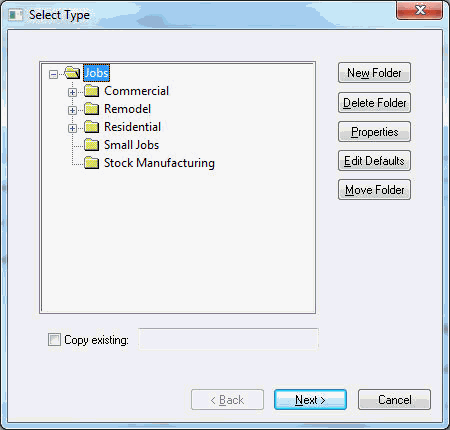
Highlight the folder in which you want to place the new job and click Next. Review the Getting Started > Adding and Deleting Job Folders section for more details on creating new folders.
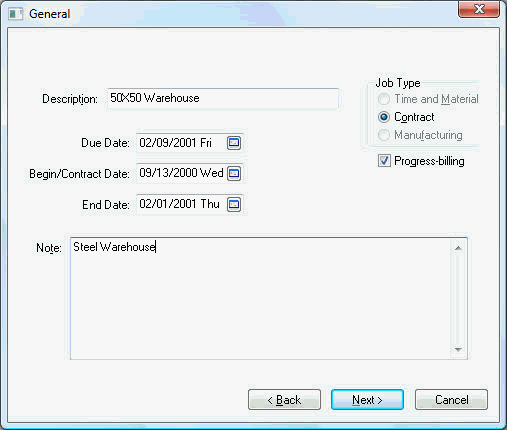
Enter the job Description as well as other miscellaneous job information within the Note field.
Set the Job Type to Time and Material if the entire job will be billed on a T&M basis. Select Contract if part of the job or the entire job is contractual. It is possible to have time and Material stages within a contract job.
The Progress-billing switch should be turned ON if the contract job is billed in stages based on the progress of the job rather than a single invoice. (Review the Progress-Billings section of this manual for more details on progress-billing.) The Progress-billing option will be disabled if the Job Type is set to Time and Material.
The Due Date should reflect the date in which a job needs to be completed. The Due, Begin, and End Date fields should all be used in scheduling a job. A job's description and date may be changed at any time. Click the Next button to continue.
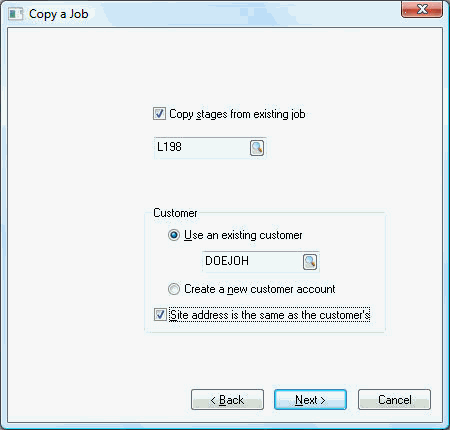
Enable the Copy stages from existing job option if you wish to copy information from another job. Keep switch OFF to use default stages. Ignore steps 9 and 10 if the Copy from Existing Job switch is OFF.
Enter an existing job that you wish to copy. To view all existing jobs click on the lookup button.
Select the Create a new customer account option if this is the first job for this customer or select Use an exiting customer option for a customer whose account has previously been established within EBMS.
Click the Site Address is the Same as the Customer's switch ON to copy the customer's address to the site tab. To view the customer's address, right click on the customer code and select the Lookup option from the context menu. Click Next to continue.
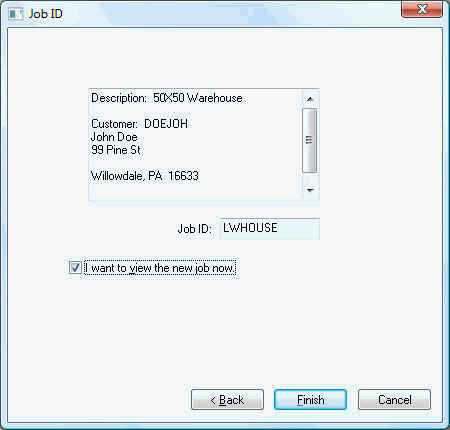
Enter a Job ID to identify the job. This code can be automatically be created by setting the appropriate naming setting within the folder. Go to Job Costing > Options > Job Folders, highlight the job folder, and click on the Properties button. Click on the naming tab to set option.
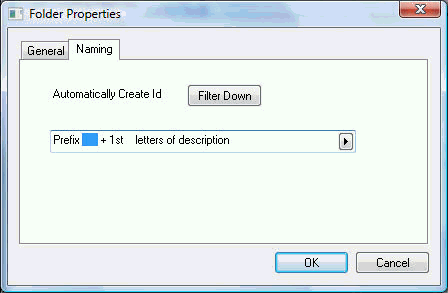
Click Finish to complete the new job wizard.
